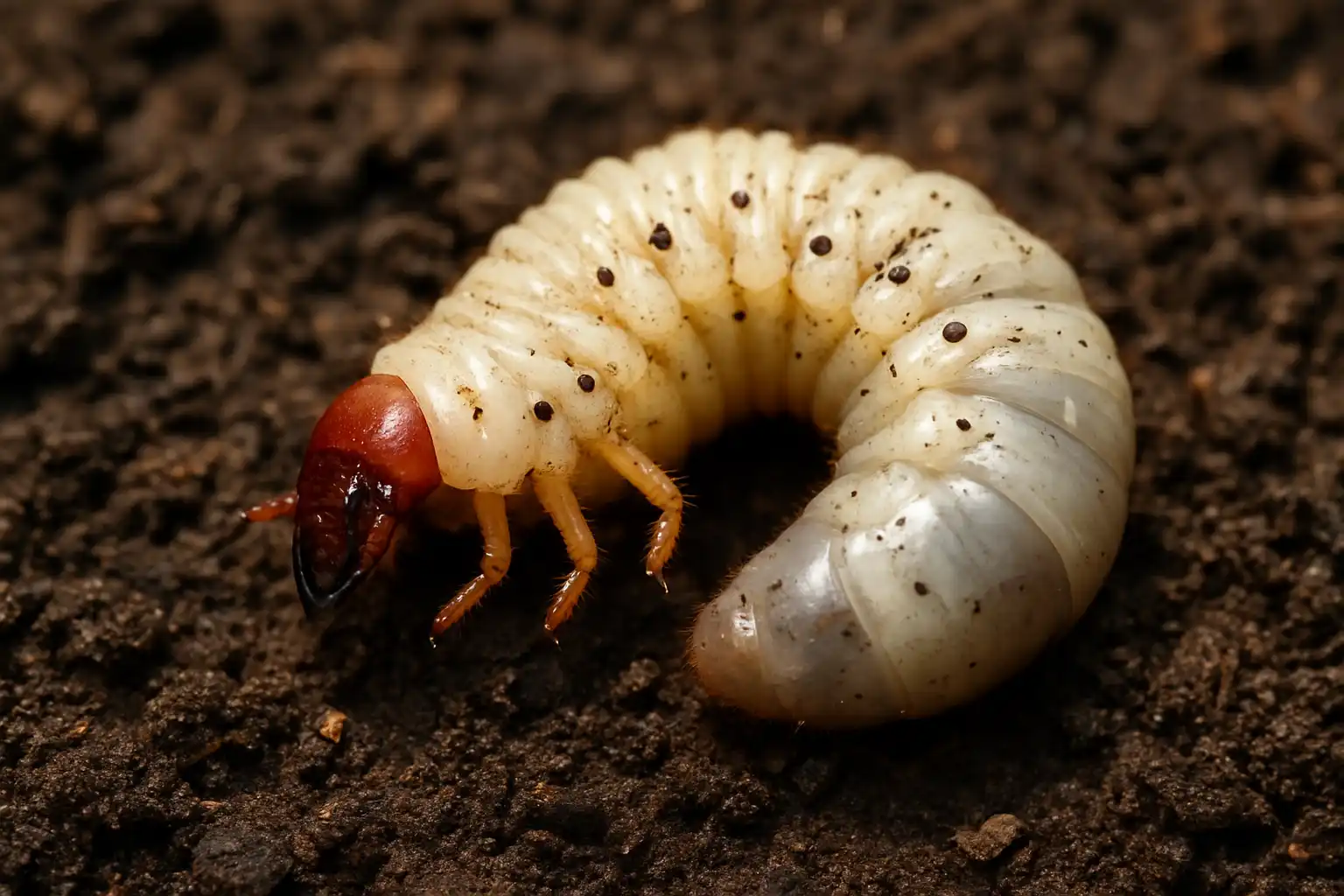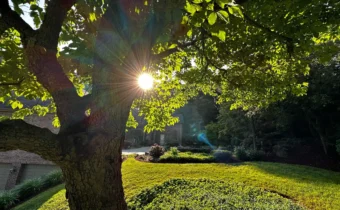Grub damage is one of the most frustrating challenges for homeowners in Pittsburgh. At Dream Greener, we’ve seen lawns with no grub control that looked perfectly healthy one week become patchy, dry, and lifeless the next — all because of a pest you can’t even see. These tiny white larvae might be out of sight, but they can quickly become a big problem if left untreated.
We’ve put together this guide to help you understand everything you need to know about grubs: what they are, how they damage your lawn, how to identify an infestation, and how to prevent and treat them effectively. Whether you’re looking for seasonal protection or facing an active infestation, this resource will walk you through the best practices for grub control in Pittsburgh, PA.
 What Are Grubs?
What Are Grubs?
Grubs are the larvae of several species of beetles that are common in Pennsylvania, including:
- Japanese beetles
- European chafers
- June beetles
Each of these beetles lays eggs in turfgrass during the summer. The eggs hatch into small, white, C-shaped larvae that live in the soil and feed on the roots of your grass. These grubs are especially dangerous because their damage isn’t visible right away — by the time most homeowners notice symptoms, the root system has already suffered significant harm.
Grubs are especially active in late summer and early fall, but they can also survive the winter and return in the spring for one last round of feeding before transforming into adult beetles. That means the damage they cause can span multiple seasons if the infestation goes untreated.
The Grub Life Cycle: Timing Is Everything
 To treat grubs effectively, we need to understand their seasonal behavior. In the Pittsburgh area, the grub life cycle typically looks like this:
To treat grubs effectively, we need to understand their seasonal behavior. In the Pittsburgh area, the grub life cycle typically looks like this:
Spring
Overwintering grubs wake up and feed briefly before pupating into beetles. Grass may already be showing signs of stress from this early feeding.
Early Summer
Adult beetles emerge, feed on plants and flowers, and lay eggs in healthy lawns — especially those that are moist and sunny.
Mid to Late Summer
Eggs hatch, and the new grubs begin feeding immediately. This is when the majority of lawn damage happens.
Fall
Grubs grow quickly and feed aggressively to prepare for winter. This is the peak period of turf damage. Once temperatures drop, they move deeper into the soil.
Winter
Grubs go dormant underground and wait for the soil to warm again.
The best time for grub control is in early to mid-summer, before the eggs hatch or while grubs are still small and vulnerable. Check out our Pittsburgh Lawn and Landscape Care Calendar for more information. And for even more details, check out Penn State’s grubs page.
Signs of Grub Damage
Grub infestations can be tricky to diagnose, especially in their early stages. Here are some of the most common signs to watch for:
- Irregular brown patches in your lawn that don’t improve with watering
- Spongy turf that feels soft underfoot or lifts up easily like carpet
- Visible grubs beneath the soil surface when you peel back sod
- Increased animal activity, like raccoons or skunks digging at night
- Weed outbreaks in areas where grass has died
If you’re unsure whether grubs are the cause of your lawn problems, we recommend performing a simple grub check: cut a 1-square-foot section of turf, peel it back, and count the grubs underneath. If you find 6 or more, that’s a sign you may need treatment. If you find 10 or more, immediate action is critical.
Why Grub Control Is Essential in Pittsburgh
Grubs aren’t just a nuisance — they compromise the health and resilience of your entire lawn. As they chew through roots, your grass loses its ability to absorb water and nutrients, leaving it vulnerable to:
- Heat and drought stress
- Fungal infections
- Weed encroachment
- Soil erosion on sloped areas
Here in Pittsburgh, where summers are warm and humid and fall weather tends to linger, conditions are ideal for beetles to thrive and reproduce. That’s why grub control should be a regular part of your lawn care strategy.
Preventing Grub Damage Before It Starts
We believe the best grub control is prevention. A few smart, seasonal steps can stop grubs before they hatch — saving you money and protecting your lawn’s long-term health.
Preventive Grub Control Treatments
We apply a professional-grade insecticide containing chlorantraniliprole in late spring to early summer. This product is safe for people, pets, and pollinators, but highly effective at targeting grubs as they hatch. When applied at the right time, it delivers season-long protection.
Soil and Turf Management
Healthy grass is naturally more resistant to grubs and other pests. That’s why we encourage:
- Annual core aeration to improve root growth
- Proper mowing (at 3 to 3.5 inches) to strengthen turf density
- Watering deeply but infrequently
- Fertilizing based on a custom soil test
- Avoiding overwatering in June and July, which attracts beetles looking to lay eggs
We also recommend planting grass types that are less attractive to beetles, such as fine fescues in shadier areas.
Dealing with Active Infestations
If you’re already dealing with visible grub damage, it’s not too late. But fast action is key.
Curative Treatments
We use curative insecticides like trichlorfon and carbaryl, which are highly effective against mature grubs. These are best applied in late August through October, when grubs are still feeding close to the surface.
Lawn Restoration Services
After treating the grubs, we help your lawn bounce back by:
- Removing damaged turf
- Overseeding with climate-appropriate grass
- Topdressing with compost to improve soil quality
- Custom fertilization to restore root health
- Seasonal follow-up to ensure grubs don’t return
Organic and Alternative Grub Control Methods
For those looking for natural or eco-conscious options, we offer several alternatives to chemical treatments:
- Beneficial nematodes, which are microscopic organisms that seek out and kill grubs
- Milky spore disease, a naturally occurring bacterium that targets Japanese beetle larvae (although this takes time to establish)
- Integrated Pest Management (IPM), combining soil health, monitoring, and low-toxicity controls
While these methods may take longer to show results, they can be part of a broader, sustainable lawn care strategy.
Grubs and Other Lawn Pests in Pittsburgh
Grubs may be one of the most visible pests, but they’re not the only threat to your lawn. Dream Greener’s pest control services also address:
- Chinch bugs
- Armyworms
- Sod webworms
- Surface-feeding insects
- Moles and voles (often secondary to grub infestations)
We develop personalized pest control plans based on your lawn’s condition, soil profile, and local climate factors.
See our full range of pest control services
Why Homeowners Trust Dream Greener for Grub Control
We’re a locally owned and operated company based right here in the South Hills of Pittsburgh. We don’t offer cookie-cutter programs — we treat every property with the care and precision we would give our own.
Clients choose us because:
- We know the Pittsburgh climate, soil, and pests
- We communicate clearly and show up on time
- Our technicians are trained, certified, and experienced
- We build long-term relationships, not one-time fixes
Grub control is just one part of our commitment to healthy, vibrant landscapes. We approach every job with the same goal: helping your lawn thrive from the roots up.
Get Ahead of Grub Damage Today
Grubs can be devastating — but with the right strategy, they’re entirely manageable. Whether you’re dealing with brown patches now or want to prevent them in the future, Dream Greener is ready to help. We offer expert pest control in Pittsburgh, PA, backed by years of experience, science-based treatments, and a passion for protecting the lawns in our community.
Contact us today to schedule a grub inspection, preventative treatment, or full-service lawn consultation. Let’s make sure your lawn stays lush, strong, and grub-free all year long.
 What Are Grubs?
What Are Grubs?


